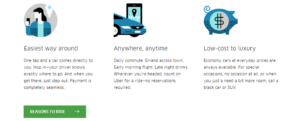Few things are more frustrating for an online retailer than realizing that their traffic isn’t converting. How do larger eCommerce stores manage to get so many conversions?
Many marketers will tell you that the answer is simple; big stores have bigger marketing budgets. While that is certainly true, there are some conversion tactics that these large eCommerce stores use that you can adopt as well.
Ready for some eCommerce inspiration? Here are six key strategies that large eCommerce sites use to attract and convert millions of customers:
- They Build Customer Trust
If you want shoppers to buy from your online store, it’s essential that you build their trust. A customer isn’t going to make a purchase or willingly give away their information if they don’t think your store is trustworthy.
Large eCommerce sites know this, which is why most them won’t be seen without the following on their site:
Trust signals: Most online shoppers look for visual cues to tell them whether your site is trustworthy. If you look at any of your favorite big name brands, they will have trust signals all over their site to help reassure consumers.
Reputable payment options: PayPal is a reputable payment option, but you should give your customers more than one option. Stripe, Authorize.net, and Google Wallet are all options to consider.
Online reviews and testimonials: Statistics show that 88 percent of customers trust online reviews as much as personal recommendations. Make sure that your reviews and testimonials are current so that they will inspire trust in your customers.
2. They Constantly Test Their Site
Big online retailers all have digital marketing tools that help them maximize their eCommerce site’s performance. In today’s competitive online space, you need to be taking advantage of data and testing tools if you want your eCommerce site to reach its full potential.
This doesn’t mean that you need to spend your entire budget on tools to test your site. In fact, many of them are free (although some paid tools can be worth it to small eCommerce businesses).
For example, a simple A/B test (also known as split testing) can tell you whether “Buy Now” or “Purchase Now” is better for your CTA button, or whether a certain color scheme increases conversions over your old color scheme.
There are many tests that large eCommerce stores are continually using to ensure that their site is optimized for conversions. Check out this list of free tools to improve your own conversions
3. They Pay Attention to the Competition
The biggest names in eCommerce constantly spy on their fiercest rivals—and you should be doing the same. By comparing your own eCommerce store to those of your peers, you can see how you stack up against the competition and identify new markets.
Keeping track of the competition isn’t something that you should feel bad about doing. Large eCommerce stores certainly don’t feel bad when they increase their conversions using the same effective strategies as their competitors. If you want to remain competitive and grow your online store, you need to be gathering information and using it to improve your own site.
4. They Lead Instead of Follow the Customer
You may have heard of customer journey mapping, the method used to plot out the key stages and experiences a customer goes through on their journey towards a purchase. Journey mapping allows marketers to better understand their customers, resolve their pain points in real time, and increase conversions in the process.
While many eCommerce businesses map the customer journey, they tend to approach it the wrong way. Rather than follow the customer’s journey, you should be proactive and pave the way for the customer instead. The average consumer goes through many steps before they make a purchase, but you can eliminate some of these steps by shaping their journey.
How does one do this, exactly? Most large eCommerce stores rely on automated marketing solutions to leverage their customer data and turn insight into action. With automated marketing platforms, it’s easier for marketers to identify pain points, solve the customer’s problems in real time, and personalize their experience to increase conversions.
If you’re worried that automated marketing is too expensive for your eCommerce business, there is good news; it’s more affordable than ever. Today, there is an automated solution that fits every budget and every eCommerce merchant needs to take advantage of that.
5. Their Value Propositions Are Clear
Why should your site’s visitors buy from you? What do you have to offer and why is it better than the competition?

Your homepage should immediately convey the answers to these questions with your value proposition. A value proposition isn’t a slogan or mission statement—it’s a clear promise that your products offer something of value to the customer.
There are good value propositions, and the
n there are exceptional value propositions that convert millions of customers. Take a look at Uber’s homepage to see value propositions done right:
The first thing a visitor sees is the headline  “Get there—Your day belongs to you.” This zeros in on one of the biggest frustrations that we have with traditional taxis. No one wants to risk wasting an entire day trying to arrange for an unreliable taxi to get them where they need to go.
“Get there—Your day belongs to you.” This zeros in on one of the biggest frustrations that we have with traditional taxis. No one wants to risk wasting an entire day trying to arrange for an unreliable taxi to get them where they need to go.
Scroll a little farther down and they list three additional reasons why Uber is superior to traditional taxis.
Clear, powerful, and convincing. Create your own value propositions that stand out, and you can start converting customers in droves.
6. They Keep Things Simple
Customers want a simple, seamless experience on your website. Unfortunately, many new eCommerce sites think that simple means “boring” and try to do way too much with their site.
All this does is create confusion, which hurts your conversion rates. Plenty of studies have been done on the matter, including one study by Google which found that users rated “visually complex” websites as less beautiful than simpler sites.
When it comes time to update your site, remember to make your website simple and clean. There is no better example than Google when it comes to this. It’s one of the most popular websites in the entire world, but it’s also incredibly simple.
This should serve as a good reminder to eCommerce site owners, large and small—users love simplicity. Keep your site simple, especially your homepage, and you will naturally optimize your conversions.
